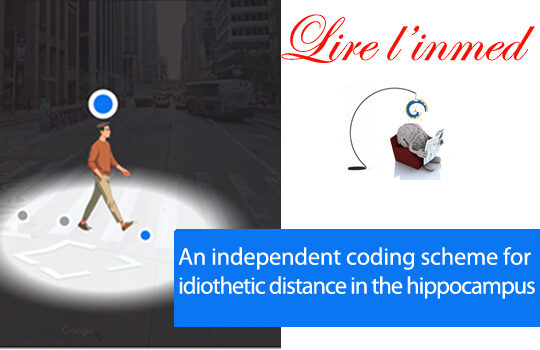
Egocentric map. Vision usually takes the lead when we navigate a landscape — a landscape that we have shaped to fit our vision. But how do we know where we are when there are no landmarks around? Fortunately, there is an overlooked « internal sense » based on self-motion cues that enables us to track our location, even in the dark. In this study, the authors found that when mice explored a virtual world without distinctive landmarks, such as a cornfield where every row looks the same, their brains built an « inner map » based not on what they saw, but on the distances they traveled. This map relies on place cells in the hippocampus working together with grid cells, which act as an internal ruler. When the grid system was disrupted, distance tracking weakened, though vision could still take over if landmarks were present. These findings point to grid cells as key operators of navigation in environments with limited cues. (IB)
The authors: M Nordlund, N Levernier, M Trippa, R Bourboulou, G Marti, R Monasson, H Rouault, J Epsztein & J Koenig-Gambini
Scientific abstract: Self-location and navigation are crucial to daily life, and their disruption is particularly disabling. The hippocampus is central to this process as well as episodic memory. Hippocampal place cells are spatially selective, increasing their activity in specific locations. When external landmarks are scarce, place cells use self-motion (idiothetic) information to track location based on distance traveled (distance coding). Distance coding may be particularly relevant to episodic memory. However, the determinants of distance coding are poorly understood. Here, we used virtual reality, electrophysiological recordings in mice, and local cue manipulations to isolate and characterize hippocampal distance coding. In cue-poor conditions, a global distance coding scheme dominated hippocampal activity with high distance indices in all place cells, including both superficial and deep CA1 pyramidal cells. The mapping of distance onto a low-dimensional manifold and rigid distance relationships between place fields are compatible with attractor dynamics similar to those observed for grid cells. Inactivation of the medial septum (MS), which disrupts grid cells, significantly reduced both distance coding and rigid distance dynamics, suggesting an alteration (but not complete abolition) of the underlying attractor. By contrast, place cell coding was also influenced by local visual cues in cue-rich environments, notably deep CA1 pyramidal cells, and this persisted under MS inactivation. We propose that grid cells and associated rigid attractor dynamics predominantly contribute to hippocampal distance coding.
Paru dans Current Biology, 2025
